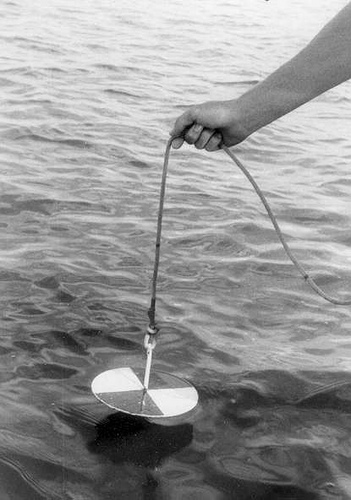- What is a Secchi disk? A Secchi disk is a circular metal plate attached to a calibrated rope. It is probably the least expensive and easiest to use tool in water quality monitoring.
Background: Father Pietro Angelo Secchi, scientific advisor to the Pope, was asked by Commander Cialdi, head of the Papal Navy, to test a new transparency instrument. This instrument, now named the “Secchi (rhymes with ekki, or Becky) disk, was first lowered from the papal steam yacht, l’Immacolata Concezione (The Immaculate Conception) in the Mediterranean Sea on April 20, 1865. One of the best aspects of the Secchi disk is that the information it provides is easily interpreted by volunteers and can be used to detect water quality trends in lakes.
There have been many revisions to the first disks used by Secchi in terms of size and color. The two most common colors variations in use today are the all-white disk and the black and white quadrant version disk. In Montana, we use the black and white quadrant, 8 inch diameter metal disk.
Water transparency is a quick and easy measurement that tells scientists a lot about a lake’s water quality. First, it indicates the amount of light penetration into a lake. Second, Secchi transparency provides an indirect measure of the amount of suspended material in the water, which in many cases is an indication of the amount of algae in the water. Long-term transparency monitoring by NMLN volunteers provides a valuable basis for detecting trends in water quality. Generally, the sooner water quality problems are detected, the easier and less expensive it is to restore the lake to its previous state.
- How much time does it take to do the monitoring properly?
It depends on how big the lake is and how far you have to go, but please allow it at least a couple of hours per monitoring session. - Is the monitoring seasonal or year-round?
Seasonal. - Do I have to bring special equipment on my own or will it all be provided?
Monitoring equipment will be provided. - Will I have to do this alone or will someone from your offices go with me?
We will attempt to have a staff person go out at least once with a volunteer monitor during the course of the monitoring season to help answer any questions. Also when more complicated water quality samples need to be taken, the volunteer will be asked if they would like to join a staff person to assist with the sampling. - I don’t have computer access, so will I still be able to do the monitoring?
Yes. - How good do my math skills have to be to do this?
You just have to be able to write legibly. - What if I want to monitor a lake or site that’s not on the list?
Depending on where the lake is you may be able to become a monitor on the that lake. Contact NMLN to see if that lake could be included in the program. - How does the NMLN program compare to others around the country?
The program is comparable to other programs around the country and uses many of the same monitoring standards that are required by the U.S. Environmental Protection Agency (USEPA). - What is your definition of Northwest Montana?
The NMLN geographic scope is predominately in the Flathead Basin, however lakes in the Eureka area are also included. - What do you do with all this data?
The NMLN produces an annual report available to the public on the health and trends of the lakes in the program. - How long do we need to monitor a given site before the data are useful?
All data is useful, even after the first sampling event. However, as more data is recorded for a given lake, a clearer picture of its health will emerge. - I’m a grad student, can I get school credit for volunteering?
Check with your educational institution or advisors. - Who gets to see the results of your efforts? How do you report your findings?
The NMLN provides an annual report to Montana Fish, Wildlife & Parks and the report is posted on this website.
Any other questions you may have, please send us an email at durae@whitefishlake.org.
Thanks.

Secchi Dip-In
Source: Biological Sciences Department Kent State University

Pietro Angelo Secchi
(1818-1878)
